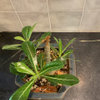Adenium Basics
ProudMamaSD
12 years ago
More Discussions
Calling all experts!
Many of us here are new, full of passion and lacking know-how. Since this is a new sect of the forum, perhaps we could use this thread to share the basic information. Fertilizer (which, how often, etc), root pruning frequency, potting up information, etc. As the forum matures there will be more focused threads that go into great detail about soil and fertilizer, but in the meantime perhaps some of you can share your routine.
Thanks Everyone,
Wendy


Marie Tran
Loveplants2 8b Virginia Beach, Virginia
Related Professionals
Fort Lee Landscape Architects & Landscape Designers · Glassmanor Landscape Architects & Landscape Designers · Kenmore Landscape Architects & Landscape Designers · Simi Valley Landscape Architects & Landscape Designers · Wareham Landscape Architects & Landscape Designers · Westwood Landscape Contractors · Avocado Heights Landscape Contractors · Hawthorne Landscape Contractors · Hayden Landscape Contractors · New Brighton Landscape Contractors · Oak Forest Landscape Contractors · Pleasant Prairie Landscape Contractors · Raleigh Landscape Contractors · Riverhead Landscape Contractors · San Rafael Landscape ContractorsProudMamaSDOriginal Author
Haname
elucas101
katluvr
elucas101
tapla (mid-Michigan, USDA z5b-6a)
keylyn
Loveplants2 8b Virginia Beach, Virginia
tapla (mid-Michigan, USDA z5b-6a)
keylyn